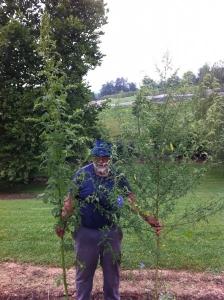Almost every gardener wants to know “What’s new?” What beautiful new plant can we be tempted with? I’m just as bad as the rest, over the winter I peruse all the catalogues and greenhouse magazines looking for the new and different. This past winter, I was struck with something I heard at symposium.
Instead of asking “What’s new?” maybe we should be asking “What works?” In a presentation of new plants, the speaker started talking geraniums. I could see everyone’s brain turn off. What is new about geraniums? Discovered in South Africa and brought back to Europe in the 1600s, they have been in our gardens forever. How many of us remember an ancient geranium in our mother or grandmother’s window that was set out every summer?
The presenter showed a dramatic picture of how hardy geraniums are. A grouping of mixed pots in front of his office contained various annuals all blooming beautifully. His co-workers went on a week-long retreat and the automatic water system broke down. They came back and everything was dead– except –you guessed it– the geraniums.
The ubiquitous pot with a red geranium, green spike and vinca vine is almost a cliché– because it works so well. Along with pansies, osteospermums and dianthus, they are one of the most-cold bedding plants. They also stand up to summer heat and days when the watering can was forgotten.
There are two main types of geraniums; ivy and zonal. Ivy geraniums are generally trailing, have smaller flowers heads, and are commonly seen in hanging baskets and window boxes. Zonal geraniums are upright, with larger flowers and a characteristic dark ring or “zone” on the foliage. Zonals are propagated either from seed, or from cuttings, ivies are almost exclusively from cuttings.
All geraniums benefit from sun, and supplementation with liquid fertilizer. If grown too wet, sometimes they can develop root diseases but its not generally a problem. Ivies can get oedema, little raised bumps along the stems when temps are cool, and wet, but it is more cosmetic than catrostrophic.
There are some new genetics. The Calliope and Caliente series come to mind. These crosses between ivy and zonal geraniums are beautiful and share the best characteristics of both. Calliope Deep Red is the best selling red geranium for several years now. Novelties like variegated foliage, or star-shaped flowers add additional interest.
Geraniums may not be new, but they work.
 A po
A po